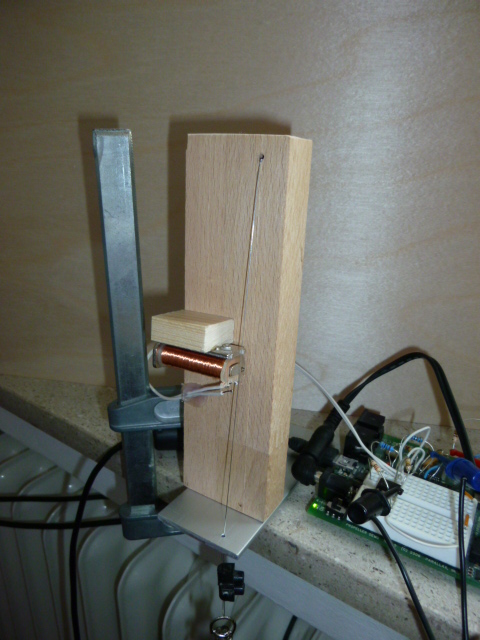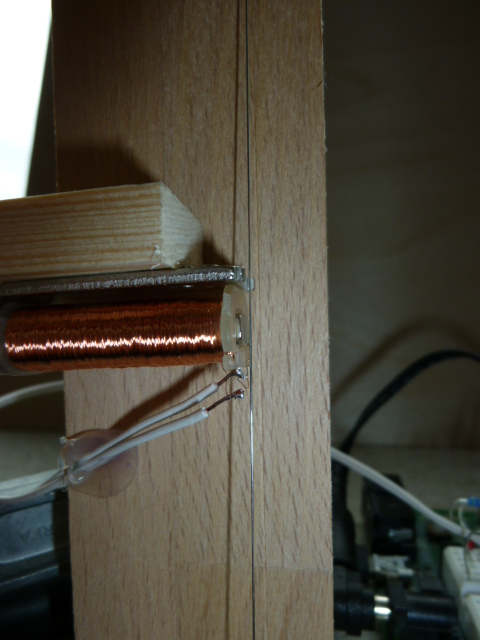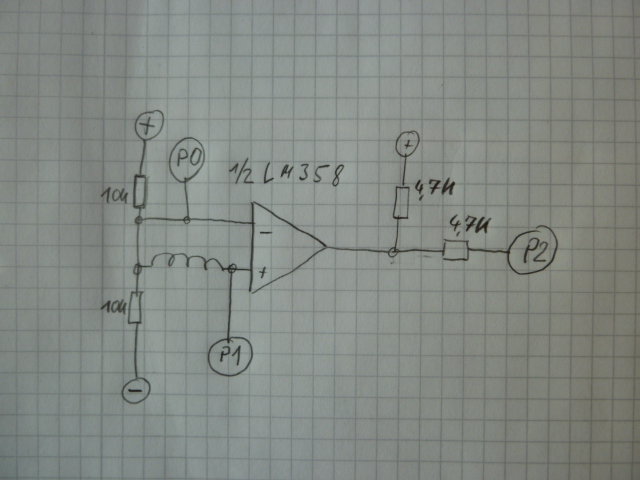A Physics Experiment: Measure a Force or a Weight with the Propeller
VibWire_I.c
17.03.2012 by CWE
A Physics Experiment: Measure a Force or a Weight with the Propeller
for PropGCC demoboard (or others) , output to Terminal
LMM with -O2 speed
What can a Propeller measure best? Frequency!
So this is a setup to measure a force or a weight using the
capability to output and to measure a frequency. It is the resonance frequency of a string.
These sensors can be build with great long term stability and are called vibrating wire sensors.
So a Vibrating Wire Sensor finds resonance frequency of a wire string, that is strained by the applied force.
Can be used to build a weighing machine, when the force is a weight.
mass= freq*freq/constant
As you can see in the pictures, the mechanical setup is quite simple.
You will have to find out the right constant for your setup.
The wire is driven by a coil by a burst with the output frequency.
Then the wire frequency is measured using the same coil as a pickup.
The driving frequency is adjusted to meet the wire frequency. In my setup a burst has to be used,
because the solenoid is weak.
It is nice, that you can switch ports from output (for the burst) to high impedace inputs.
I use a LM 358 as an amplifier with open loop. By chance the output is low, when there is no signal.
The amplifier has a rather slow output slope. This leads to the problem, that the fast propeller can count
electrical noise during 1 low-high changement. This is the reason for the //debounce-lines.
In my setup a selenoid from a relay is used. The string is an electric guitar B string.
It is about 14cm long and has a frequency of about 340Hz with a mass of 432grams.
The function to measure the frequency is a little special, because it shall not
get stuck, when there is no signal (constantly low input).
Second speciality is, that the loop fits into fcache, which gives better resolution.
The resolution of the scales is quite high - 0.01 grams. The mass has to be very still for
good results. The weighing machine is rather slow, because it has to find the resonance frequency.
Of course there is room for improvement. Make it faster or do some linearising.
Thanks a lot for the help in the forum!
And thanks for PropGcc with SimpleIDE!
Comments and applications welcome!
Have fun with your experiments,
Christof
17.03.2012 by CWE
A Physics Experiment: Measure a Force or a Weight with the Propeller
for PropGCC demoboard (or others) , output to Terminal
LMM with -O2 speed
What can a Propeller measure best? Frequency!
So this is a setup to measure a force or a weight using the
capability to output and to measure a frequency. It is the resonance frequency of a string.
These sensors can be build with great long term stability and are called vibrating wire sensors.
So a Vibrating Wire Sensor finds resonance frequency of a wire string, that is strained by the applied force.
Can be used to build a weighing machine, when the force is a weight.
mass= freq*freq/constant
As you can see in the pictures, the mechanical setup is quite simple.
You will have to find out the right constant for your setup.
The wire is driven by a coil by a burst with the output frequency.
Then the wire frequency is measured using the same coil as a pickup.
The driving frequency is adjusted to meet the wire frequency. In my setup a burst has to be used,
because the solenoid is weak.
It is nice, that you can switch ports from output (for the burst) to high impedace inputs.
I use a LM 358 as an amplifier with open loop. By chance the output is low, when there is no signal.
The amplifier has a rather slow output slope. This leads to the problem, that the fast propeller can count
electrical noise during 1 low-high changement. This is the reason for the //debounce-lines.
In my setup a selenoid from a relay is used. The string is an electric guitar B string.
It is about 14cm long and has a frequency of about 340Hz with a mass of 432grams.
The function to measure the frequency is a little special, because it shall not
get stuck, when there is no signal (constantly low input).
Second speciality is, that the loop fits into fcache, which gives better resolution.
The resolution of the scales is quite high - 0.01 grams. The mass has to be very still for
good results. The weighing machine is rather slow, because it has to find the resonance frequency.
Of course there is room for improvement. Make it faster or do some linearising.
Thanks a lot for the help in the forum!
And thanks for PropGcc with SimpleIDE!
Comments and applications welcome!
Have fun with your experiments,
Christof







Comments
keep in mind that since your nodes are essentially anchored ... one at the top and the other being the weight, the optimal position for your sense coil is in the center. Looks like that's what you have setup.
You might also find that at 1/4 of the way in from your anchor points you will see another optimal position at 2X the frequency that you have right now. .... then again at 1/8th, 1/16 , and so on .. each time the fundamental frequency should double. The reason I mention that, is because if you are using a 'tuned' coil, meaning that it is in parallel with a capacitor, and the values are resonant within the mid-range of your 'wire' frequency you should see a substantial increase in signal gain on your signal detection. ... higher frequencies are easier to tune than the lower ones and don't require as big of a coil capacitor combo. If you can create a workable frequency range in a couple of hundred kHz, then tuning those coils shouldn't be too painful. If you stay in the audible range, then the coil/capacitor value will be rather large.